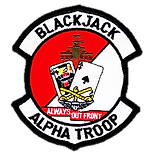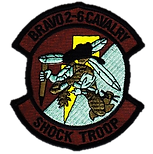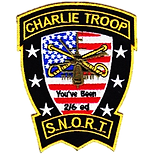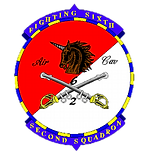
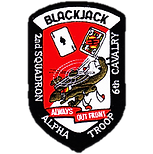
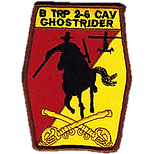
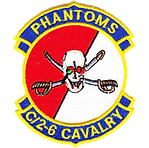
2nd Squadron, 6th Cavalry
Lightning Horse
Operations DESERT SHIELD/STORM
(1986 - 1996)
On 16 July 1986, the CARS was updated and renamed the U.S. Army Regimental System (USARS). It was on this same date that the 2nd Squadron, 6th Cavalry (2-6 CAV) was reactivated to become part of the 6th Cavalry Brigade, and was the third unit to receive the AH-64 Apache. In January 1988, the Squadron moved from Fort Hood, Texas to Illesheim, Germany as part of the 11th Aviation Brigade of VII Corps and was formally assigned to U.S. Army Europe.
As tensions increased in the Middle East, following the August 1990 Iraqi invasion of Kuwait, the Squadron deployed to Saudi Arabia, as part of Task Force 11 in support of OPERATION DESERT SHIELD. During combat operations as part of OPERATION DESERT STORM, the unit flew three major combat missions, destroying over 200 armored vehicles of the Tawakalna and Medenah Republican Guards Division, for which it earned the Valorous Unit Citation.
Operations JOINT ENDEAVOR/GUARD
(1996 - 1997)
In the summer of 1996, the 11th Aviation Group (which included 2-6 CAV) received a warning order to form and train an aviation task force for possible deployment to Bosnia-Herzegovina. The deployment was to be as a part of the Task Force Eagle Covering Force, overseeing the withdrawal of the 1st Armored Division. On 4 October 1996, the Group received its deployment orders, and within five days began departing Germany enroute to Tuzla, Bosnia-Herzegovina in support of Operation JOINT ENDEAVOR. Assembling at Comanche Base, the 700 Soldiers of Task Force 11 transferred authority with their 1st Armored Division counterparts on 4 November 1996, and immediately provided critical support to MND (North), where tensions between the Former Warring Factions were high. On 20 December, the covering force completed its mission as a part of the Implementation Force and transitioned to operations as a part of the Stabilization Force. On 15 May 1997, the 229th Aviation Regiment executed transfer of authority with Task Force 11 as the Multi-National Division (North) Aviation Brigade. After processing at the intermediate staging base in Taszar, Hungary, the last elements of Task Force 11 closed on their home stations on 25 May 1997. 2-6 CAV earned participation credit in support of peacekeeping operations JOINT ENDEAVOR and JOINT GUARD.
Operation ALLIED FORCE
(1999)
The call to duty came again in April 1999, when the unit deployed to Albania and prepared to conduct combat operations as part of Operation ALLIED FORCE. Upon capitulation of Serbian forces, 2-6 CAV redeployed in July 1999 to continue serving as V Corps "tip of the spear."
Operations DESERT SPRING/IRAQI FREEDOM
(2002 - 2003)
2-6 CAV deployed to Kuwait in September 2002 as part of the build-up in support of OPERATION IRAQI FREEDOM. At that time, it was part of OPERATION DESERT SPRING, and the aircrews and planners were comfortable with conducting operations in the desert environment. By the time the rest of the 11th ACR arrived in Kuwait (which included a sister squadron; 6-6 CAV), the squadron had flown some 4,000 hours training in the Kuwaiti desert. In January 2003, the rest of the 11th ACR alerted to deploy to Kuwait and learned that it would receive attachment of the 1-227th Attack Helicopter Battalion (AHB). Thus, the regiment would consist of three AHBs fitted with the most advanced attack helicopters in the world. The squadron participated in the first ‘deep attack’ of the war, against the Iraqi Medina Division. All 13 AH-64 Apaches that flew that night suffered battle damage, and none came back with fewer than six bullet holes. Four cockpits had taken rounds, as had four fuel cells. Ten days after a rough first engagement, the squadron got back in the Battle for Baghdad. During this second engagement, CW2 William B. Smith and 1LT Nathan Schmidt scored the unit’s first kills of the war. 2-6 CAV was the first V Corps unit sent to combat, and spent an eight-month rotation in Kuwait and Iraq. The squadron returned home in May 2003.
Fort Hood, Texas
(2003 - 2004)
On 26 June 2003, less than six weeks after returning, 2-6 CAV folded its flag and inactivated in Germany. The squadron shipped its aging Alpha-model Apaches back to the Boeing manufacturing plant in Mesa, Arizona, to be refurbished as Longbows. The squadron, meanwhile, re-formed at Ft. Hood, Texas and the squadron’s flag was unfurled 12 September 2003 at that location, having been reactivated under 21st Cavalry Brigade for the Unit Fielding and Training Program. Under the leadership of LTC Mike Swanson, a whole new groups of aviators, mechanics, crew chiefs, and support personnel had to learn new jobs. Only three officers and three Soldiers were holdovers from the squadron that fought in Iraq the previous year. After nine-months of classroom, flight, and field exercises, the Army certified the squadron as combat-ready on 18 June 2004 in the AH-64D “Longbow” helicopter. It was the tenth army unit to receive the Longbows. Upon completion of training, it prepared to return to Illesheim, Germany. On 26 July 2004, the first four helicopters buzzed through the rain-drenched skies, skirting the bottoms of low, gray clouds that planted themselves directly over their German home. The main body of 224 Troopers arrived on 13 August.
Operation ENDURING FREEDOM VI
(2005 - 2006)
After redeployment to Germany, 2-6 CAV conducted training operations ensuring readiness prior to its deployment. The squadron absorbed elements from other units, to include Chinooks, Blackhawks, and Apaches, and was task organized as Task Force Sabre, part of the 12th CAB (TF Griffin). On 4 January 2005, TF Sabre was deployed to Afghanistan to support Operation ENDURING FREEDOM VI. It supported Regional Command-East (RC-East) and was divided between Bagram, Kandahar, Salerno, and Jalalabad. On 6 June 2006, upon redeployment, the squadron deactivated in Germany.
Schofield Barracks, Hawaii
(2006 - 2015)
On 9 June 2006, the 1st Battalion, 25th Aviation Regiment (1-25 AVN RGT) was inactivated at Wheeler Army Airfield (WAAF), Schofield Barracks, Hawaii. Its personnel reflagged as 2-6 CAV and reactivated. In conjunction with this move, the squadron traded in the AH-64 Apache for the OH-58D Kiowa Warrior and was re-designated as an Armed Reconnaissance Squadron.
Operation IRAQI FREEDOM
(2006 - 2007)
From July 2006 to October 2007, 2-6 CAV, as part of the 25th CAB (Task Force Wings), deployed for a fifteen-month tour of duty to Iraq for its second tour in support of OPERATION IRAQI FREEDOM. The squadron was stationed in Kirkuk at Contingency Operating Base Speicher and Forward Operating Base Warrior, where it performed combat operations in support of 3/25 IBCT. For its exemplary service the squadron was awarded the Meritorious Unit Commendation and credit for the Iraq NATIONAL RESOLUTION and IRAQI SURGE campaigns.
Operation IRAQI FREEDOM
(2009 - 2010)
From August 2009 to August 2010, 2-6 CAV (task organized as Task Force Lightning Horse), as part of the 25th CAB (Task Force Wings), deployed for a twelve-month tour of duty to Iraq for its third tour in support of OPERATION IRAQI FREEDOM. The squadron once again operated out of COB Speicher, and served under the 3rd ID. It earned participation credit for the IRAQI SOVEREIGNTY campaign.
Operation ENDURING FREEDOM
(2012 - 2013)
From January 2012 to January 2013, 2-6 CAV, as part of the 25th CAB (Task Force Wings), deployed for a twelve-month tour of duty to RC South in Afghanistan. The squadron was under the leadership of LTC Thomas O’Connor and CSM Keith Hunter, and stationed at Kandahar Airfield, Kandahar Province, and performed combat operations in support of OPERATION ENDURING FREEDOM. For its service, the squadron received participation credit for the Afghanistan TRANSITION I campaign.
Republic of Korea
(2013 - 2015)
In 2013, the Army began deploying units for nine-month rotations to the Republic of Korea (RoK) in an effort to increase the combat capability and overall force readiness to defend its allies on the Korean Peninsula. 2-6 CAV would become the third Aviation Reconnaissance Squadron to support the endeavor.
The majority of 2014 was spent preparing for the upcoming deployment, and the year concluded with the squadron’s Culmination Training Exercise (CTE) from 12 through 18 November 2014 at Makua Valley.
On an overcast 15 January 2015, at WAAF, Hawaii, the 25 OH-58s assigned to 2-6 CAV ceremonially flew their final flight. After circling Wheeler Army Airfield, landing, and shutting down, the Aviators of 2-6 CAV exited their aircraft and partook in their departure ceremony. Among the many distinguished visitors were the 25th Infantry Division Command Team. Colonel Hawley, the 25th CAB Commander and a previous 2-6 CAV commander, gave the commencement speech.
On 20 January 2015, the main body departed Hawaii and arrived the following morning at Osan Airbase, Republic of Korea. The squadron was subsequently stationed at Camp Humphries and assigned to the 2nd CAB, 2nd Infantry Division.
On 9 February 2015, 2-6 CAV conducted its Relief in Place/Transfer of Authority (RIP/TOA) with 6-17 CAV, whereupon the squadron officially assumed the mission in Korea. The ensuing nine-month rotation saw the squadron participate in Exercises KEY RESOLVE, FOAL EAGLE, PACIFIC PATHWAYS, FURIOUS TALON, and PUCKETT, before redeployment in October 2015.
Kiowa Warrior Divestment
(2014 - 2015)
In 2014, while 2-6 CAV prepared for its deployment, the squadron simultaneously prepared to retire its entire aircraft fleet, as in April 2014 the Army initiated the Kiowa Warrior Divestment Program as part of the larger Aviation Restructuring Initiative (ARI). The plan called for the OH-58 Kiowa Warrior to be retired and replaced by the AH-64 Apache aircraft. Consequently, many actions were simultaneously conducted in regard to the deployment to Korea as well as divestment.
On 9 February 2015 (the same day the main body deployed), the Rear Detachment flew the Kiowa Warriors on their final administrative flight to Joint Base Pearl Harbor-Hickam (JBPHH). The aircraft were then folded and prepared to be loaded onto cargo planes which had Arizona as their destination. The squadron’s aircraft where then laid to rest at the Boneyard, minus two exceptions. On 30 April 2015, the Pacific Aviation Museum received one Kiowa Warrior as a donation, and on 5 June 2015, aircraft no. 216 was demilitarized and put on display at WAAF’s historical display near Kawamura Gate.
On 15 October 2015, and with the squadron back from its deployment, the Pacific Aviation Museum hosted a dual-purpose event. The event began with the squadron’s uncasing ceremony, which officially marked the end of the deployment. This was followed by a sunset ceremony, whereupon a Hawaiian Kahu blessing was bestowed upon the aircraft before being put on permanent display. This officially retired the OH-58 Kiowa Warrior aircraft from Hawaii.
The Apache Era
(2016 - Present)
On 6 January 2016, four AH-64E Guardians assigned to the 16th CAB departed JBPHH and flew in formation, which arrived at WAAF. Their six-month mission was to train with 2-6 CAV and simultaneously support the 25th Infantry Division during the upcoming exercise LIGHTNING FORGE 17-01. 2-6 CAV congruently focused on preparation for inventory, reception, and execution of port operations for its 24 AH-64Ds scheduled to arrive during the months of March and April. This task also involved delivery of new AVUM equipment and certification of new 15R and 15Y maintainers.
In April 2016, 2-6 CAV received its 24 Apache helicopters at the Port of Honolulu. After a few days of maintenance, the aircraft were flown from the port to WAAF where they made their new home. This action was memorialized on 10 June 2016, when 2-6 CAV formally welcomed its Apache fleet during a blessing ceremony at WAAF.
In July 2016, 2-6 CAV participated in Rim of the Pacific (RIMPAC) 2016 - the largest maritime exercise in the world. On the 19th instant, the squadron boosted its proficiency in tactics, targeting, and live-fire during a sinking exercise (SINKEX) with the decommissioned Pearl Harbor frigate USS Crommelin (FFG-37).
In September 2016, the squadron conducted its first aerial gunnery exercise with Apaches at Pohakolua Training Area (PTA).
In November 2016, the squadron participated in Exercise LIGHTNING FORGE 17-02, the Division CTE.
2-6 CAV now stands as the vanguard of the Pacific, with the 25th CAB as its higher command at Wheeler Army Airfield, Schofield Barracks, Hawaii. The squadron remains vigilant and committed to conducting combat operations, and remains "LED BY LOVE OF COUNTRY!"
